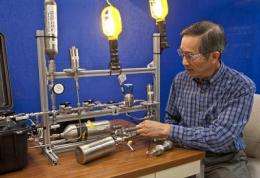SRNL research paves way for portable power systems

Developments by hydrogen researchers at the Savannah River National Laboratory (SRNL) are paving the way for the successful development of portable power systems with capacities that far exceed the best batteries available today. SRNL's advances in the use of alane, a lightweight material for storing hydrogen, may be the key that unlocks the development of portable fuel cell systems that meet the needs for both military and commercial portable power applications.
SRNL has demonstrated a practical path to portable power systems based on alane and similar high capacity hydrogen storage materials that provide the sought-after high specific energy, which means the amount of energy per weight. Their accomplishments to date include developing a lower-cost method of producing alane, developing a method to dramatically increase the amount of hydrogen it releases, and demonstrating a working system powering a 150 W fuel cell. Portable power equipment manufacturers are looking for systems that can provide specific energies greater than 1000 watt-hours per kilogram (Wh/kg); that's more than 2 to 3 times the capacity of the best primary lithium batteries today. "Higher specific energy means more energy per weight," said SRNL's Dr. Ted Motyka. "The goal is to provide sufficient energy to a system that is light enough to be carried by a soldier or used in unmanned aircraft and other applications where weight is a factor."
Hydrogen, at 33,000 Wh/kg, has the highest specific energy of any fuel, so it is a natural candidate to fuel such high-capacity systems. The challenge, however, has been developing a material for storing hydrogen with both the high capacity and the low weight needed for portable systems.
SRNL has been working for years on developing several light-weight, high capacity solid-state hydrogen storage materials for automotive applications. While most of these materials do not meet all the various requirements needed for automotive applications, many may be viable for small portable power systems.
One of the most promising materials is aluminum hydride, (AlH3) or alane. Alane, while not a new material, has only in the last few years been considered as a hydrogen storage material for fuel cell applications. SRNL researchers are among only a handful of researchers, worldwide, currently working with alane and beginning to unwrap its material and engineering properties.
Dr. Motyka, Dr. Ragaiy Zidan and Dr. Kit Heung, all of SRNL, led a team to characterize and optimize alane as a hydrogen storage material, develop a small hydrogen storage vessel containing alane, and demonstrate hydrogen release at delivery rates suitable for powering small commercial fuel cells. The results of that work are attracting interest from several commercial companies working in the area of portable power systems.
Alane is one of the classes of materials known as chemical hydrogen storage materials. Like metal hydrides, chemical hydrogen storage materials provide a solid-state storage medium for hydrogen. Unlike metal hydrides, however, chemical hydrogen storage materials, like alane, do not readily reabsorb hydrogen, so once their hydrogen is released the material must be chemically reprocessed to restore its hydrogen. An advantage of alane is its very high hydrogen capacities; it can store twice as much hydrogen, in the same volume, as liquid hydrogen, and can do so at the very high gravimetric capacity of 10 wt%. Alane also exhibits very favorable discharge conditions, making it one of the ideal chemical hydrogen storage materials.
Among the biggest challenges the team addressed were the limited amount of readily available commercial alane, and its high cost to produce – which could be significant impediments to widespread use. As part of this project, they initially developed a bench-scale system to produce the quantities of alane needed for experimental and optimization studies. This work led to the development of a new and potentially lower cost process for producing alane. "Our process overcomes some of the handicaps of traditional methods for producing alane," says Dr. Zidan. "This novel method minimizes the use of solvents, and is able to produce pure, halide-free alane."
Work led by Dr. Zidan also resulted in a process to increase the amount of hydrogen that can be extracted from alane. This two-step process was found to double the amount of hydrogen that can be liberated from alane using a traditional one-step process.
A major part of this project was to evaluate alane systems for compatibility with small fuel cell applications. Preliminary results on a proof-of-concept vessel containing approximately 22 grams of alane showed that the system could scale nicely to meet the required hydrogen release rate for a small 100-watt fuel cell system. Based on those results a larger system containing 240 grams of alane was designed, fabricated and tested with a 150 watt commercial fuel cell. The results show that the system was able to operate the fuel cell at near full power for over three hours and at reduced power for several more hours.
Provided by Savannah River National Laboratory


















